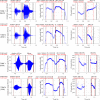Processing of Acoustic Information in Lexical Tone Production and Perception by Pediatric Cochlear Implant Recipients
- PMID: 31281237
- PMCID: PMC6596315
- DOI: 10.3389/fnins.2019.00639
Processing of Acoustic Information in Lexical Tone Production and Perception by Pediatric Cochlear Implant Recipients
Abstract
Purpose: This study examined the utilization of multiple types of acoustic information in lexical tone production and perception by pediatric cochlear implant (CI) recipients who are native speakers of Mandarin Chinese. Methods: Lexical tones were recorded from CI recipients and their peers with normal hearing (NH). Each participant was asked to produce a disyllabic word, yan jing, with which the first syllable was pronounced as Tone 3 (a low dipping tone) while the second syllable was pronounced as Tone 1 (a high level tone, meaning "eyes") or as Tone 4 (a high falling tone, meaning "eyeglasses"). In addition, a parametric manipulation in fundamental frequency (F0) and duration of Tones 1 and 4 used in a lexical tone recognition task in Peng et al. (2017) was adopted to evaluate the perceptual reliance on each dimension. Results: Mixed-effect analyses of duration, intensity, and F0 cues revealed that NH children focused exclusively on marking distinct F0 contours, while CI participants shortened Tone 4 or prolonged Tone 1 to enhance their contrast. In line with these production strategies, NH children relied primarily on F0 cues to identify the two tones, whereas CI children showed greater reliance on duration cues. Moreover, CI participants who placed greater perceptual weight on duration cues also tended to exhibit smaller changes in their F0 production. Conclusion: Pediatric CI recipients appear to contrast the secondary acoustic dimension (duration) in addition to F0 contours for both lexical tone production and perception. These findings suggest that perception and production strategies of lexical tones are well coupled in this pediatric CI population.
Keywords: children; cochlear implant; cue trading; lexical tone; speech production.
Figures










Similar articles
-
Acoustic Assessment of Tone Production of Prelingually-Deafened Mandarin-Speaking Children With Cochlear Implants.Front Neurosci. 2020 Nov 4;14:592954. doi: 10.3389/fnins.2020.592954. eCollection 2020. Front Neurosci. 2020. PMID: 33250708 Free PMC article.
-
Processing of Acoustic Cues in Lexical-Tone Identification by Pediatric Cochlear-Implant Recipients.J Speech Lang Hear Res. 2017 May 24;60(5):1223-1235. doi: 10.1044/2016_JSLHR-S-16-0048. J Speech Lang Hear Res. 2017. PMID: 28388709 Free PMC article.
-
Phonetic complexity affects children's Mandarin tone production accuracy in disyllabic words: A perceptual study.PLoS One. 2017 Aug 14;12(8):e0182337. doi: 10.1371/journal.pone.0182337. eCollection 2017. PLoS One. 2017. PMID: 28806417 Free PMC article.
-
Lexical tone and word recognition in noise of Mandarin-speaking children who use cochlear implants and hearing aids in opposite ears.Cochlear Implants Int. 2009;10 Suppl 1:120-9. doi: 10.1179/cim.2009.10.Supplement-1.120. Cochlear Implants Int. 2009. PMID: 19195003
-
Cantonese Tone Perception for Children Who Use a Hearing Aid and a Cochlear Implant in Opposite Ears.Ear Hear. 2017 Nov/Dec;38(6):e359-e368. doi: 10.1097/AUD.0000000000000453. Ear Hear. 2017. PMID: 28678079
Cited by
-
Voice emotion recognition by Mandarin-speaking pediatric cochlear implant users in Taiwan.Laryngoscope Investig Otolaryngol. 2022 Jan 13;7(1):250-258. doi: 10.1002/lio2.732. eCollection 2022 Feb. Laryngoscope Investig Otolaryngol. 2022. PMID: 35155805 Free PMC article.
-
Acoustic Assessment of Tone Production of Prelingually-Deafened Mandarin-Speaking Children With Cochlear Implants.Front Neurosci. 2020 Nov 4;14:592954. doi: 10.3389/fnins.2020.592954. eCollection 2020. Front Neurosci. 2020. PMID: 33250708 Free PMC article.
-
How Vocal Emotions Produced by Children With Cochlear Implants Are Perceived by Their Hearing Peers.J Speech Lang Hear Res. 2019 Oct 25;62(10):3728-3740. doi: 10.1044/2019_JSLHR-S-18-0497. Epub 2019 Oct 7. J Speech Lang Hear Res. 2019. PMID: 31589545 Free PMC article. Clinical Trial.
References
-
- Bharadwaj S. V., Graves A. G., Bauer D. D., Assmann P. F. (2007). Effects of auditory feedback deprivation length on the vowel /epsilon/ produced by pediatric cochlear implant users. J. Acoust. Soc. Am. EL 121 196–202. - PubMed
-
- Boersma P., Weenink D. (2018). Praat : Doing Phonetics by Computer” [computer program]. Version 6.0.37 Available at: http://www.praat.org/ (accessed January 1, 2018).
Grants and funding
LinkOut - more resources
Full Text Sources

